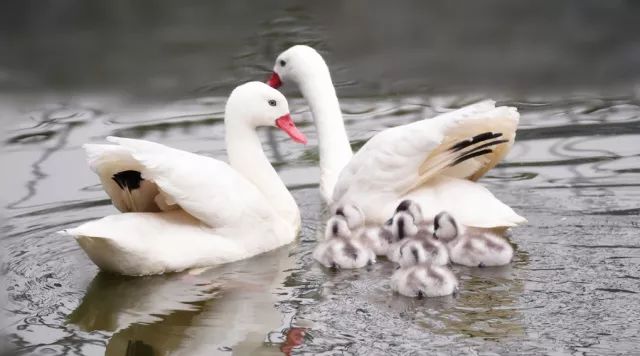flat-billed swan
IUCN
LCBasic Information
Scientific classification
- name:flat-billed swan
- Scientific Name:Coscoroba coscoroba,Coscoroba Swan
- Outline:Waterfowl
- Family:Anseriformes Anatidae
Vital signs
- length:90-115cm
- Weight:3.8-4.6kg
- lifetime:around 20 years old
Feature
It looks like a goose, with a red beak and feet.
Distribution and Habitat
Distributed in South America, including Colombia, Venezuela, Guyana, Suriname, Ecuador, Peru, Bolivia, Paraguay, Brazil, Chile, Argentina, Uruguay and the Malvinas Islands.
Flat-billed swans usually move in low-altitude areas, with the highest recorded height reaching 1,000 meters. Prefers large lakes, swamps and freshwater ponds, and is also found on brackish Brazilian beaches. It likes to live in fresh or slightly salty swamps, lakes and lagoons where aquatic plants such as cattails, banana grass, rushes, reeds and duckweeds exist. In the dry season, it spreads to inland grasslands, estuaries and beaches. , sometimes even inhabit coastal areas where a large amount of seaweed grows, feeding on various algae growing on rocks.
Appearance
The body feathers of the flat-billed swan are white, and the tip of the sixth main feather is black. Because it is very close to the wings, it is difficult to see at ordinary times, but it is very obvious when flying. The beak and feet of the goose are red. The appearance of the flat-billed swan is more like that of a goose, without the black cheeks of a swan, and the sexes are similar. The feathers of young geese are mixed and fuzzy, with brown-gray down.
Details
Flat-billed swans mainly live in the water. When swimming, their necks are bent and their heads are lowered, showing an extremely elegant posture. When flying, the neck is straight forward, the legs are stretched back, and the wings are flapped slowly and powerfully. It mainly feeds on various aquatic plants, seaweeds, algae and a small amount of aquatic insects, fish eggs and crustaceans. In some places, it mainly feeds on a certain kind of aquatic plants. When foraging, they mostly choose open shallow water areas and constantly poke their heads and necks into the water to feed on the abundant food on the upper surface of the water, but they rarely stand upside down in the water to feed. Black-necked swans are less courageous and highly vigilant. When frightened, they scream and flap their wings and fly away from the water. But usually, its cry is very weak, sounding like a wheezing sound, and it doesn't carry very far.
When foraging for food, flat-billed swans mostly choose open shallow water areas, constantly dipping their heads and necks into the water to feed on the abundant food on the upper surface of the water, but they rarely stand upside down in the water to feed. Black-necked swans are less courageous and highly vigilant. When frightened, they scream and flap their wings and fly away from the water. But usually, its cry is very weak, sounding like a wheezing sound, and it doesn't carry very far.
The female incubates the eggs, while the male stands guard after hatching and actively helps protect the young from predators.

Flat-billed swans travel in flocks and mix with other waterfowl species. Usually there are small flocks of less than 100 birds, but they can reach more than 200 birds during moulting. During the flight, one or two can be seen among the flamingos and black-necked swans.
The breeding season is spring and summer, and courtship rituals are intense, usually by lowering the head and stretching the neck to chase the opponent. After the male and female birds pair up, they live together, always inseparable for foraging, activities, etc., and then find a secluded place to build a nest together. The nest is usually built on reeds or on small islands, and the nest materials are mainly made of grass, branches, etc. Each clutch lays 5-8 eggs, which are cream-colored, with an average egg size of 8.9 × 6.1 cm and a weight of 170 grams. The female bird is responsible for incubating the eggs alone, while the male bird is on guard near the nest. When the female bird leaves the nest to look for food, she will temporarily incubate the eggs. The incubation period is approximately 35 days. The average weight of a hatchling is 110 grams. When the chicks hatch, the male will attack intruding predators. The hatched chicks are precocious and are raised by the male and female birds together. Since the adult bird moves in the water almost all day long, the chicks lie on the adult bird's back and follow the adult bird's movements. When the chicks are 3 to 4 months old, they can fly long distances with the geese.








